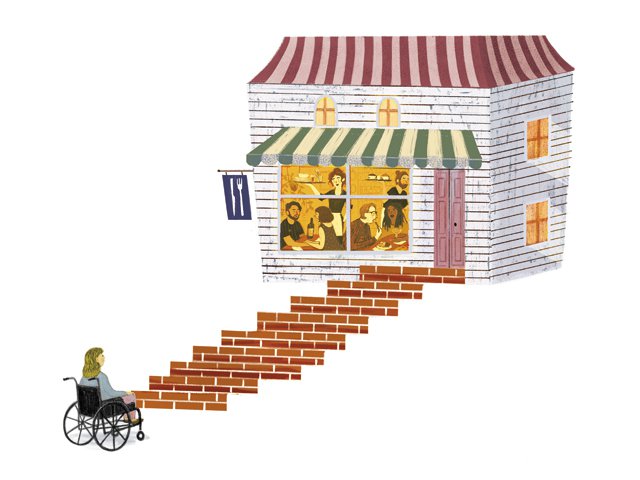SPORK! Exclusive: When A Blinded Person Sees: Charles Bonnet Syndrome

In 1759, retired magistrate Charles Lullin detailed to his secretary a series of visions he’d seen after he’d lost much of his eyesight: tales of handsome, vanishing men with regal cloaks who’d accompanied his granddaughters on a visit; black specks that transformed into pigeons; a handkerchief that drastically shrank or grew depending on where he looked. These images looked so much a part of the world around him that they seemed real, yet he knew they were not.
Magistrate Lullin’s description almost reads like the plot of a movie. In many films, ghosts and fairies and other fantastical things are completely real. Larger than life, these creatures interact with the humans who inhabit their realm: singing with them, dancing with them, even clasping their hands and guiding them through the night sky.
Though Lullin could have very well been a character in a fantastical movie, he actually had Charles Bonnet Syndrome, or CBS. Described initially in 1760 by Lullin’s grandson, the philosopher Charles Bonnet, CBS is defined by three hallmarks: vision loss, either partial or complete; hallucinations; and the marked realization that the hallucinations aren’t real.
--------------------------------------------------------------------------------------------------------
Put another way: instead of existing inside the world of a film, people with CBS are instead watching a silent production unfolding around them, a production of which they are not actually a part. Indeed, the fact that the hallucinations do not directly interact with the individuals themselves often distinguishes CBS from other disorders like schizophrenia. Patients with CBS are well aware that something isn’t quite right. They are lucid, articulate, intelligent; testing negative for a swath of possible psychiatric and neurological diagnoses.
In short, people with CBS know that the visions aren’t something to be afraid of—even if they have to reassure themselves sometimes. But many are afraid for an entirely different reason: they don’t want to be labeled as somehow not right in the head.
That’s a major reason why the actual prevalence of CBS isn’t well characterized. Aside from its encompassing description—CBS can last from a few moments to months on end; occur in both the young and the elderly, in people who’ve lost at least some of their sight to a variety of causes—CBS isn’t usually immediately reported, if at all. Due to this lack of self-reporting, researchers have predicted numbers from less than one to over 40 percent of all people with some form of vision loss as having CBS.
Uncertainty also plagues the causes of CBS, where vision loss is a mandatory but insufficient requirement. Charles Lullin, for instance, had cataracts that left him almost blind. Others have glaucoma. Still others suffer from tumors that compress the nerve leading to the eye.
The vision loss doesn’t have to come from a disease, either. One study simply looked at people who had been blindfolded for five days straight. Participants began hallucinating within an average of one day.
All of this isn’t meant to imply that all, or even most, people who have impaired vision will suffer from CBS. Rather, because CBS can arise from so many different causes, doctors often misdiagnose it as a more serious condition, like psychosis or schizophrenia or dementia, leading to unnecessary and/or incorrect treatment.
Although no set cure exists, CBS doesn’t often necessitate drug intake. The most common treatments involve making vision better through surgery or other means, and psychological counseling for those who don’t feel comfortable with the hallucinations.
--------------------------------------------------------------------------------------------------------
In analogy, CBS is sometimes called the “phantom vision” syndrome. When someone who is used to seeing all of the world around them suddenly or gradually can’t see all of it anymore, their brain fills in the gaps in vision, which manifests itself as the many images associated with CBS.
Some folks who have CBS find it fascinating. Others, more than a tad distressing. For all of its mystifying attraction, however, there still remains a discordant note between awareness of CBS and proper diagnosis—almost 300 years after the initial report.
-----------------------------------------------------------------------
If you’d like to learn more about Charles Bonnet Syndrome, I’d recommend Oliver Sacks’s TED talk on the subject. You can view the TED talk here.
References:
- Draaisma, D. (2009). Disturbances of the mind. (B. Fasting, Trans.). New York, NY: Cambridge University Press. (Original work published 2006)
- Greener, M. (2014). Charles Bonnet syndrome: an enigmatic neurological condition. Progress in Neurology and Psychiatry, 18(2), 6-8.
- Jacob, A., Prasad, S., Bogglid, M., & Chandratre, S. (2004). Charles Bonnet syndrome—elderly people and visual hallucinations. BMJ, 328, 1552-1554.
- Menon, G.J., Rahman, I., Menon, S. J., & Dutton, G. N. (2003). Complex visual hallucinations in the visually impaired: the Charles Bonnet syndrome. Survey of Ophthalmology, 48(1), 58-72.
- Sacks, O. (2009). What hallucination reveals about our mind. Retrieved from https://www.ted.com/talks/oliver_sacks_what_hallucination_reveals_about_our_minds?language=en
- Charles Bonnet syndrome: why am I having these visual hallucinations? Retrieved from http://www.visionaware.org/info/your-eye-condition/guide-to-eye-conditions/charles-bonnet-syndrome/125



